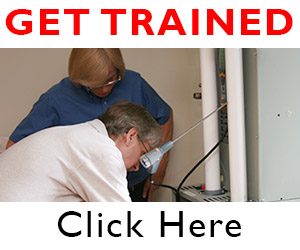Lead Installers: In addition to previously mentioned training, if your lead installers also ‘commission’ the system, both from the air side and refrigerant side, they would greatly benefit from an Air Balancing Certification. Over time consider getting them trained in HVAC System Performance as well.
Installation Manager: As with your Service Manager, your Installation leader should receive training and coaching to help integrate airflow improvements into your current processes and procedures. This helps to ensure a seamless and profitable transition.
Salespeople (Comfort Advisors) and Sales Manager: Your salespeople and sales manager should know how to measure static pressures. Preferably they will also carry an airflow hood so at the minimum they can spot check the registers and grilles of trouble rooms.
Duct System Optimization should be their go-to training to get started right away with integrating testing into your sales process.
While Combustion and CO Safety training could certainly be helpful, they should at the minimum carry a portable CO safety device or Low Level Monitor with them into every home they enter.
The Duct System Optimization class will also help them a great deal with offering Air Upgrades on installations, and, in some cases, more involved duct renovations.
This knowledge helps to keep them out of trouble when replacing equipment on poorly performing air distribution systems.
Non-Technical Personnel – CSRS/Dispatchers: Your office personnel will benefit greatly from going through all, or at least the first days of Duct System Optimization and Combustion and CO Safety training. This will help them better understand how it all fits into the company culture you are working to create.
Just as important, they will be able to share what your company does differently with customers. Even a little knowledge about these two areas will go a very long way in terms of helping customers understand why they should do business with your company.
Owner/General Manager: As an owner or general manager, you should try to take all of the training mentioned above, pacing yourself of course, so you don’t get overwhelmed. Beside the technical knowledge, doing this helps you see how the whole approach fits together. This is key.

As your organization’s leader, it’s critical you formulate how High Performance will integrate with your company’s Vision and Mission. In each class you will see opportunities to monetize the different services your company will be able to offer.
Your role is to put the picture together from a 30,000 foot view, both from a short-term and long-term perspective.
Over the years we’ve seen hundreds of owners attend classes much later after they sent a tech to training, wishing they’d paid closer attention to the business opportunity sooner. Many tell us they could kick themselves for not attending with their people.
When you sit through the training with your team, you will have dozens of ‘AHA!’ moments. You’ll see tremendous opportunities normally missed by relying on the troops alone to give you feedback on how to make everything work for your organization.
Some important advice: If you participate in the training ‘ get fully immersed. It will be tempting to constantly be pulled out of the room to solve problems and jump on immediate pressing business. Unless your building is on fire, wait for breaks and lunch to respond to phone calls and texts.
 Formal Versus Ongoing Internal Training
Formal Versus Ongoing Internal Training
While attending two or three-day classes is essential to getting a solid start, few people have the ability to retain everything they’ve learned in such a short time. In education circles, they say a 20% retention rate is very good.
So it’s important to establish ongoing internal training to reinforce your team’s knowledge and keep it fresh. Part of this ongoing program should be regular short training sessions on very speci’c topics.
Weekly training is ideal for reinforcing speci’c areas like interpreting static pressure, design basics, understanding friction rates, duct installation, and sealing techniques, and so forth. There are dozens of topics you could cover in 30-minute training sessions.
Nearly all NCI test procedures can be easily adapted as curriculum for reinforcement training. We also offer many online courses your team can take to refresh their knowledge and fill in areas that may have missed in the classroom training.
Online training is a great reinforcement tool, but it’s no substitute for live training where your people are interacting with the instructor, participating in class conversations, and performing hands-on testing. These three factors are key to cementing knowledge and skills.
One of the key tenets of training is it is never done. It needs to become part of your company’s culture, and should be done on purpose, budgeted, and an integral part of your business plan.
Once trained, it’s critical that your field people have the tools to apply their newly learned skills as soon as possible.
In the seventh part of this ongoing series we’ll take a deep dive into the proper tools and instruments that will help your team succeed and progress on their path to delivering and maintaining High-Performance HVAC systems.












Recent Comments